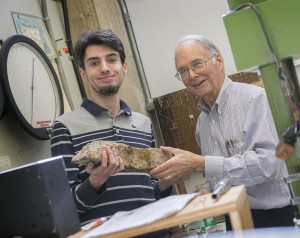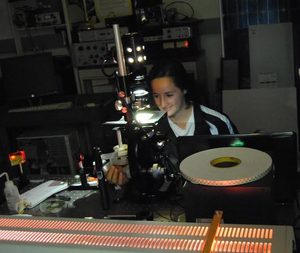Simons Fellows Recognized at Intel Talent Search Award Ceremony
Two Stony Brook University Simons Summer Research Program alumni were honored at the Intel Talent Search Award Ceremony on March 11, 2014, in Washington D.C.
Kevin Lee of Irvine, California, received second-place honors for his work using principles of fluid mechanics to develop a mathematical model of the shape of the heart as it beats. His computationally efficient model has the potential to provide insights into heart conditions and may lead to improved treatments. As a runner-up in the talent search, Lee received a $75,000 scholarship.
Aron Coraor of Huntington, New York, took sixth place for his project investigating why a mineral found in the highlands of the moon exists in two different forms. For this research accomplishment, Coraor received a $25,000 scholarship.
Lee was mentored by professor of physics Tzu Chieh Wei during the Stony Brook summer program and later completed the Intel project in California. Coraor also conducted his Intel research after completing the Simons program, supervised by Stony Brook’s Distinguished Professor Emeritus Donald Lindley.
Simons Summer Research Program Sends Three Fellows to the Intel Science Talent Search Finals

Three students who participated in the Simons Summer Research program at Stony Brook University in New York are finalists in this year’s Intel Science Talent Search, one of the country’s most prestigious science research competitions for high school seniors.
Stony Brook faculty in the sciences mentored Simons Fellows Kathy Camenzind, Emily Pang, Kevin Lee and Aron Coraor over the past summer, providing them with hands-on research experience.
During the 2013 program, Kathy Camenzind worked with professor John Noé and visiting scholar Marty Cohen, from the department of physics and astronomy, to develop her project, “Quantifying Trapping Forces in a Simplified Optical Tweezers Setup.” “My mentor was incredibly helpful,” says Camenzind. “We had long conversations about how I could shape my project into something that was both attainable during the seven-week research program, yet still unique and relevant.”
Camenzind’s project aimed to develop inexpensive optical tweezers — used to trap microscopic particles in three dimensions. Her work showed that functional optical tweezers can be developed at low cost — and in college or high school laboratories.
Emily Pang worked with professor Berhane Ghebrehiwet during the 2013 program on her project, “The Opposing Roles of Tumor Suppressive cC1qR and Oncoprotein gC1qR as Mechanisms

for Inhibiting Cancer Pathogenesis.” Pang identified immune protein receptors critical to the growth and suppression of tumors that could contribute to our current understanding of cancer pathogenesis and be used in developing new cancer treatment and therapies.
Kevin Lee worked with physics and astronomy professor Tzu Chieh Wei on his Simons project, and later with a University of California, Irvine mentor on his Intel project to develop a mathematical model describing the shape of the heart as it beats. Lee’s model could provide insights into arrhythmia and inform research on improved treatments for the disease.
Aron Coraor was selected by Intel for his project “Pressure Dependent Azeotropic Melting Relations in the Mg2SiO4-Fe2SiO4-NaAlSi3O8-CaAl2Si2O8 System: A Critical Role in Lunar Highlands Formation?” Although Coraor participated in the Simons Summer Research Program, he conducted this research with a Stony Brook mentor in another context over the past two years. His mentor, Distinguished Professor Emeritus Donald Lindley, helped Coraor examine the processes by which the moon was formed.
“During the Simons program, I was able to develop a deeper understanding of the physics underlying my project,” says Coraor. “And my mentor was instrumental in promoting that understanding.”

“It is so rewarding to hear about the remarkable research that’s done by these outstanding high school students guided by their faculty mentors,” says Marilyn H. Simons, President of the Simons Foundation. “Hopefully, this program will inspire and launch some terrific careers in science.”
In addition to Camenzind, Pang and Coraor, 18 Simons Fellows were selected as semifinalists in the talent search.
The Intel Science Talent Search winners will be announced at a black-tie gala at the National Building Museum on March 11, 2014. Intel finalists will travel to Washington D.C. in March for the selection of the ten winners, who will share $630,000 in winnings. The first-place winner will receive $100,000.


